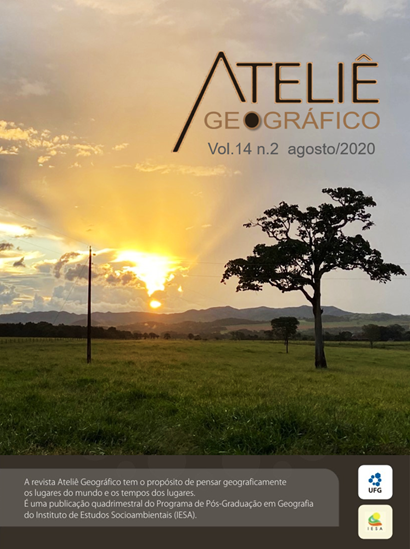Cycle of supercontinents and morphostructural reflexes in Northwest Ceará /Brazil
DOI:
https://doi.org/10.5216/ag.v14i3.63793Abstract
Geological history records the occurrence of four supercontinents (Columbia, Rodínia, Panotia/Gondwana and Pangea). Traces of these events are recognized in the Northwest of Ceará through the following episodes: (1) Transamazonian/Atlantida Orogenesis (continental Columbia masses), generating the Granja Complex (2.0 Ga); (2) Columbia division generating klippe (1.7 Ga); (3) rifting of Rodinia (800-750 Ma), with deposition of neoproterozoic supracrustal sequences; (4) agglutination of Panotia/Gondwana (Orogenesis Brasiliana, 665-590 Ma), creating the Brasiliana Chain; (5) collapse of orogens and formation of the Jaibaras and Parnaíba basins, from the division of Panotia (530-515 Ma); (6) deposition of the Serra Grande Group in the Parnaíba Basin (440 Ma), associated with the drift of Gondwana; (7) intracontinental rifting (145-120 Ma) generating uplifting of the Parnaiba Basin and exhumation of granites, followed by the opening of the Atlantic, from the fission of Pangea/Gondwana (120-100 Ma); 8) flexural uplifting of the interior of the continent (from 65 Ma), with exhumation of massifs, crustal reactivation in the Meruoca Massif and circunsdenuation in the Parnaíba Basin, generating the Glint of Ibiapaba.
Keywords: supercontinents; plate tectonics; megageomorphology.
Downloads
Downloads
Published
How to Cite
Issue
Section
License
Autores que publicam nesta revista concordam com os seguintes termos:- Autores mantém os direitos autorais e concedem à revista o direito de primeira publicação, com o trabalho simultaneamente licenciado sob a Licença Creative Commons Attribution que permite o compartilhamento do trabalho com reconhecimento da autoria e publicação inicial nesta revista.
- Os autores não serão remunerados pela publicação de trabalhos na Revista Ateliê Geográfico. Além disso, os conteúdos publicados são de inteira e exclusiva responsabilidade de seus autores, ainda que reservado aos editores o direito de proceder a ajustes textuais e de adequação às normas da publicação.
- Autores têm permissão e são estimulados a divulgar seu trabalho online (ex.: em repositórios institucionais ou na sua página pessoal), já que isso pode gerar alterações produtivas, bem como aumentar o impacto e a citação do trabalho publicado (Veja O Efeito do Acesso Livre).


